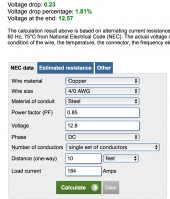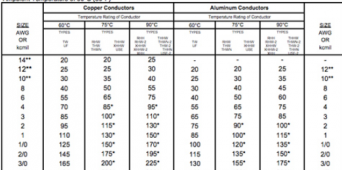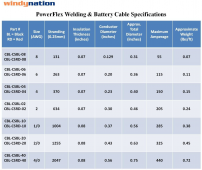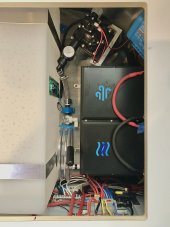sunrise
New Member
- Joined
- Jul 16, 2020
- Messages
- 206
I plan to tackle the under powered inverter (1000w) problem, but due to the constraint of available space (I have a 16-foot trailer, space is very limited), the inverter has to be mounted far from the batteries. about 10 feet of cable run.
I have read many posts on similar topics. In most posts, "bigger is better" suggestion was often offered, which I understand - can't hurt if the size of the wire isn't going to get in the way. But I want to really understand the problem that a setup could run into will smaller gauge wires (say 2awg). So here is the setup I am considering -
- Renogy 2000w pure sine wave inverter (11v - 16v working voltage range)
- 210ah LiFePo4 batteries (2 105ah in parallel with 2 120a JBD smart BMS)
- 9-10 feet 2awg from batteries to inverter, roundtrip 20 feet
- Load - most of time < 200w AC, 2-3 minutes 800w microwave, 2-3 minutes 1200w coffee machine, 1500w hair dryer for 2-3 minutes(very rarely), 15A AC breaker ensures the load would never go above 1800W.
BTW, my original factory installed 1000W inverter also has a very long 4awg cable run between battery and inverter (9 feet or so). I tested it with a space heater @ 800w for about 5 minutes and it seems to be fine, without any cable overheating.
AWG 2 pure copper wire is rated for 200A, so I don't think I need to worry about safety here, especially when I will never go above 150A, anything above 100A would only be used for ~ 3 minutes. But for safety's sake let's say I will run 150A for 2 hours, I expect the wire will get warm, but shouldn't be a fire hazard anywhere.
The next one is voltage drop. according to Blue Sea Wire Wizard, 12v, 150A, 20 feet (roundtrip) would have up to 4%(0.48v) voltage drop, my LiFePo4 batteries should stay above 12v most of it's discharge cycle, so 12v - 0.48 = 11.52v, still well within inverter's operational range. not too mention this is the extreme case @ 150A.
So are there any other problem this setup would likely run into? Again I am full aware a 4/0 wire would be better than 2awg, but I just want to understand the issue with smaller gauged wire.
Anyway, I think the folks that came up with amp ratings for different wire sizes already built safety margin into them. So I am wondering if layers of oversizing are really necessary.
Thanks in advance!
I have read many posts on similar topics. In most posts, "bigger is better" suggestion was often offered, which I understand - can't hurt if the size of the wire isn't going to get in the way. But I want to really understand the problem that a setup could run into will smaller gauge wires (say 2awg). So here is the setup I am considering -
- Renogy 2000w pure sine wave inverter (11v - 16v working voltage range)
- 210ah LiFePo4 batteries (2 105ah in parallel with 2 120a JBD smart BMS)
- 9-10 feet 2awg from batteries to inverter, roundtrip 20 feet
- Load - most of time < 200w AC, 2-3 minutes 800w microwave, 2-3 minutes 1200w coffee machine, 1500w hair dryer for 2-3 minutes(very rarely), 15A AC breaker ensures the load would never go above 1800W.
BTW, my original factory installed 1000W inverter also has a very long 4awg cable run between battery and inverter (9 feet or so). I tested it with a space heater @ 800w for about 5 minutes and it seems to be fine, without any cable overheating.
AWG 2 pure copper wire is rated for 200A, so I don't think I need to worry about safety here, especially when I will never go above 150A, anything above 100A would only be used for ~ 3 minutes. But for safety's sake let's say I will run 150A for 2 hours, I expect the wire will get warm, but shouldn't be a fire hazard anywhere.
The next one is voltage drop. according to Blue Sea Wire Wizard, 12v, 150A, 20 feet (roundtrip) would have up to 4%(0.48v) voltage drop, my LiFePo4 batteries should stay above 12v most of it's discharge cycle, so 12v - 0.48 = 11.52v, still well within inverter's operational range. not too mention this is the extreme case @ 150A.
So are there any other problem this setup would likely run into? Again I am full aware a 4/0 wire would be better than 2awg, but I just want to understand the issue with smaller gauged wire.
Anyway, I think the folks that came up with amp ratings for different wire sizes already built safety margin into them. So I am wondering if layers of oversizing are really necessary.
Thanks in advance!







